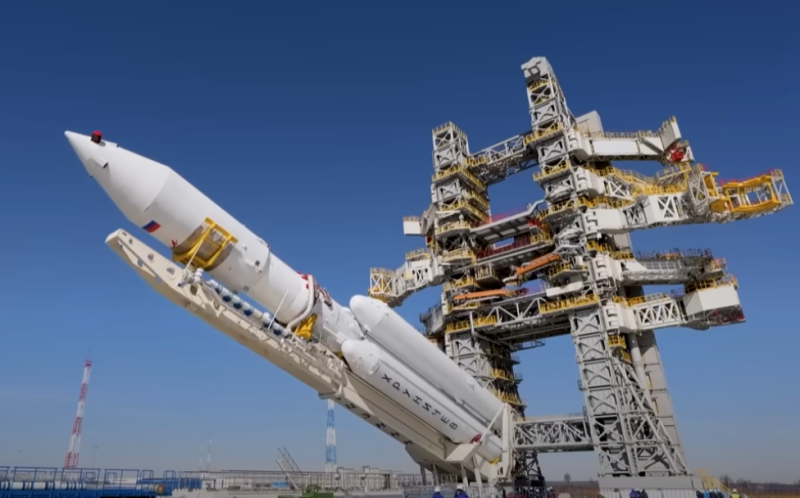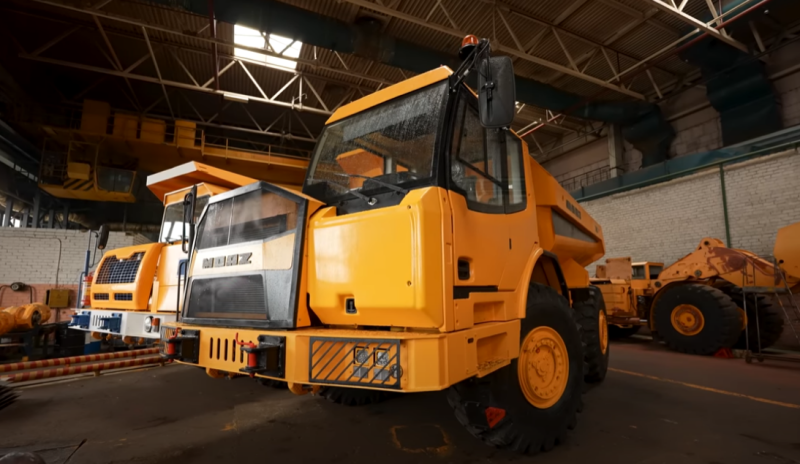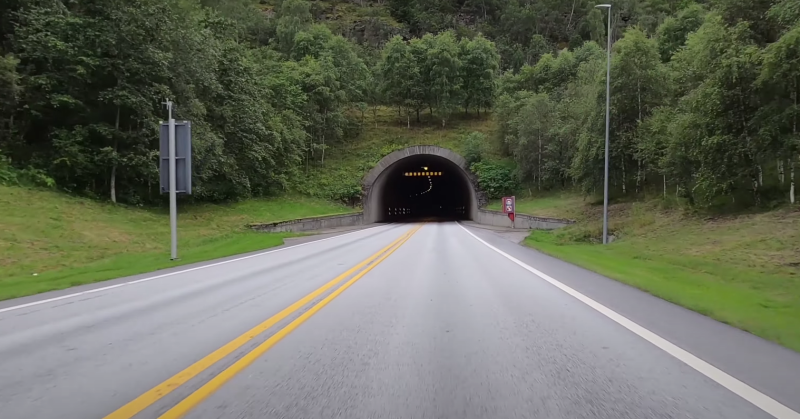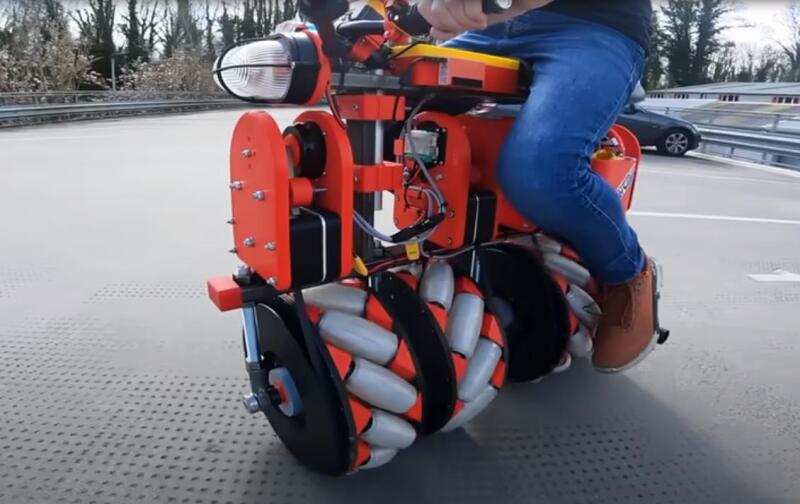However, now we can safely state that for almost two hundred years of history, the original design has practically not changed. The only significant event was the transition from steam to electric traction. But due to curiosity, it is still interesting to find out exactly what projects were proposed and why they were not implemented. Our country was no exception, and “grand” projects were also considered in Russia.
Shilovsky's gyro train
From the very beginning of the railway industry, namely in the 20s of the 19th century, some inventors tried to prove the obvious promise of a single-rail gauge. Among them was our domestic "Kulibin" - Ivan Elmanov. It was he who became the founder of the monorail, the so-called "Road on Pillars", the project of which dates back, according to some sources, to 1820. However, unfortunately, at that time it was not possible to find investors for its implementation.
 The decision looks strange, but the serious economic benefits are obvious. Photo: YouTube.com
The decision looks strange, but the serious economic benefits are obvious. Photo: YouTube.comThe idea of "one rail" in Russia returned only after almost 100 years. This happened thanks to the nobleman-inventor Pyotr Petrovich Shilovsky. He became the creator of a technology called "A device for maintaining the balance of carts or other bodies in an unstable position." The amateur engineer even patented his work in 1909. This is documented not only by the Russian model, but also by a number of European countries.
In 1911, Shilovsky, who was then governor of the Kostroma province, decided to present his invention to the public. And so, at the exhibition dedicated to the 75th anniversary of the Tsarskoye Selo road, he enthusiastically described to all those present the principle of operation of his gyro train.
It consisted in the use of a continuously rotating device to maintain the stability of the vehicle throughout the entire journey along one track. The success was unequivocal. The prospects for this original technique were more than obvious to everyone. It should be noted, among other things, there were many ideas about the introduction of the gyroscope in the aviation, ship and automotive industries. The technology showed great promise, but for a number of objective reasons, things did not go further than paper.
 The railroad tracks look extremely unusual. Photo: YouTube.com
The railroad tracks look extremely unusual. Photo: YouTube.comAs for the gyrotrain, despite the Civil War, it still managed to be launched. It was given the significance of the national level and the responsibility for its implementation was assigned to the Special Commission of the Supreme Council of the National Economy. Literally in a year, a group of engineers led by Shilovsky creates a detailed project of both the canvas itself and the train with a gyroscope.
It was conceived as a two-car train with a capacity of up to 400 people, equipped with two internal combustion engines with a total capacity of 500 hp. With. and own generating station. The new locomotive was able to develop a record speed of 150 km / h at that time. As a result, a section of a single-rail track with a length of 12 km was even laid on the segment Detskoye Selo - Srednyaya Rogatka. However, the project did not meet the challenges of that time, and in 1922 all work was stopped. So far, they have not been able to recover.
ball train
Another bold decision to improve the railway communication in our country was presented by a young engineer Nikolai Yarmolchuk. His vision was to create a completely new design for the undercarriage of the train and the track itself. In 1924, he presented a development that replaced the usual rails with a rounded chute-tray, and a spherical wheel that was resistant to beats came to the forefront of movement.
 With the help of a balloon train from Leningrad to Moscow it would take 2 hours. Photo: YouTube.com
With the help of a balloon train from Leningrad to Moscow it would take 2 hours. Photo: YouTube.comIn the original version, a completely new form of wagons was assumed, including both the passenger cabin and all power units. Such a train was called "Sharoelektrolotkovy transport." Its creator tried with all his might to convey all the advantages of his offspring to higher authorities. He insisted that its implementation would allow, among other things:
✅ reduce the cost of laying the canvas
✅ increase cargo and passenger capacity
✅ multiply increase speed characteristics
✅ use sectional factory assembly
✅ reduce the consumption of materials, etc.
However, no arguments yielded results, and the project turned out to be not so promising. At least until the end of the 20s. it was not in demand because of its high cost.
Based on this, Yarmolchuk decided to finalize the balloon train and make some changes. He refused spherical wagons, suggesting that they leave their usual shape. The train was supposed to be driven by huge metal "balls" covered with rubber. Inside these wheels was an electric motor that transmitted torque using a gear train.
The power plant was mounted under the axle, which ensured an optimal distribution of the center of gravity and, accordingly, maximum wheel stability.
Taking into account all the innovations, calculations were made, on the basis of which the ball train really appeared as a “perfect” transport. He could carry up to 110 passengers at a simply unthinkable speed - 300 km / h. Arguments about reducing travel time on the Moscow-Irkutsk route to a little more than a day had an effect.
The success of design calculations was crowned in 1931 with the opening of funding of 1 million rubles. for the construction of a balloon train and the allocation of a site. Throughout the year, work was carried out on laying a wooden trough track with a length of 3 km and building an experimental car. In the spring of 1932, the first 6-meter copy with a diameter of 80 cm was ready. Spheroids with a diameter of more than 1 m were installed in the head and tail parts. By the autumn, 4 more cars were assembled.
 Perhaps modern technology could breathe new life into the development of Yarmolchuk. Photo: YouTube.com
Perhaps modern technology could breathe new life into the development of Yarmolchuk. Photo: YouTube.comAfter numerous checks in 1933, a decision was made to build a full-fledged flume route Moscow-Noginsk. However, the new station did not open at the appointed time. Among the reasons are the complexity of structures, and disputes about the resource of the wheel against the background of a shortage of rubber, and, in principle, the insufficient level of technology at that time.
Soviet maglev
Another innovative project brought to the testing stage is the TA-05 Car. True, work on the creation of this transport on a magnetic cushion began already at the "sunset" of the USSR era in the 80s. Perhaps this was the main reason for his lack of demand. After all, according to the developers, this technology opened up wide opportunities.
It was planned that the new train, which moves on the principle of magnetic levitation, could be raised above the main highways of the city and unload the traffic flow. At the same time, based on calculations, the organization of 1 km of movement of the new train should have cost almost 5 times cheaper than the subway.
Wagons weighing 40 tons and 19 meters long were capable of carrying 65 people each, with the possibility of coupling into full-fledged trains. The expected speed was within 250 km / h, and in the future - all 400 km / h. And that's with minimal noise.
 The only practical use of the magnetoplan was participation in the filming of a science fiction film. Photo: YouTube.com
The only practical use of the magnetoplan was participation in the filming of a science fiction film. Photo: YouTube.comFor testing the magnetic plane in Ramenskoye, a small 600 m section of an experimental high-speed track was built. There were plans to lay a new railway line from Yerevan to Abovyan with a length of 16 km. However, everything was canceled after a terrible earthquake in 1988. And soon, due to the unstable political situation in the USSR, funding completely stopped and the project was “mothballed”. But we must give him his due - at different times the idea was again returned, but due to various circumstances, it was never brought to the end.
What about today?
It is difficult to argue about why such promising and interesting developments in all respects did not have the proper result, and were not continued. Perhaps they were a little ahead of their time, and due to some elementary technical difficulties they could not be implemented. Well, or indeed, some aspects of innovative developments did not find a proper solution and were not economically feasible.
Only time will judge all these questions, and who knows, maybe soon someone will again be seriously interested in these developments and try to prove their worth once again. You look, and we will be able to see Shilovsky's gyro-train or Yarmolchuk's spherical-electronic train in action. As for the magnetic maglev, it has already found its application, however, not yet in our country.
For example, not so long ago we wrote that in China launched the world's first track on neodymium magnets. This means that new inventions and technical progress, if desired, may well give life to shelved, but at the same time promising projects.
 Russian inventors are not sitting idly by. Photo: YouTube.com
Russian inventors are not sitting idly by. Photo: YouTube.comIt should be recognized that, although not often, proposals of young engineers, based on the ideas of a century ago, still pop up. So, the Russian inventor Dakhir Semenov in 2017 presented his development based on the idea of creating an urban vehicle equipped with powerful gyroscopes. He enthusiastically talks about his "transport of the future", capable of solving, among other things, the logistical problems of large cities. Well, we look forward to when the concepts turn into prototypes.










